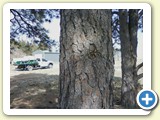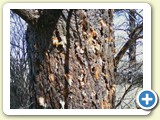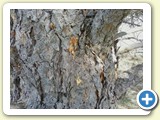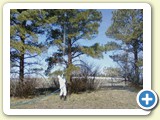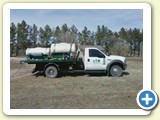- Canker Disease
- Diplodia Tip Blight of Pines
- Dothistroma Blight of Ponderosa Pines
- Wetwood
- Fireblight
- Aphids
- Ash Borers
- IPS Engraver Beetle and Mountain Beetle
- Pine Sawfly
- Spider Mites of Evergreen
- White or Woolly Pine Aphid
Canker Disease
Cankers are a fungus disease caused by a number of different pathogens and attack many varieties of trees; the following are general diagnosis and treatment practices.
Symptoms
The disease is not usually conspicuous at first but once it gets started it first kills scattered twigs and then proceeds rapidly. Cankers form in all sizes and ages of stems. Cankers range in size from small brown spots to large lesions that involve both bark and cambium. Many cankers girdle twigs and branches causing die back. The fungus may then move down into larger stems and cause perennial cankers possibly girdling the tree trunk causing premature yellowing of leaves, premature leaf drop, and possible death.
Canker diseases are most often spread in the spring and are most apt to attack those trees and ornamentals growing in infertile soil, weakened by insects and drought, or wounded plants (hail, construction, etc.). Canker diseases are most abundant in landscaped environments.
Treatments
Canker diseases can attack most varieties of trees but are most prevalent in Poplar, Willow, Spruce, Cottonwood, Aspen, Maple, Locust, Elm, and Russian Olive.
When cankers are diagnosed in a tree, the tree should be microinjected with a fungicide. If the tree appears to be in an unthrifty condition it would be recommended to microinject a combination of a fungicide and a fertilizer to give the tree a quick boost.
To build vigor in the tree a deep root feeding in the fall or very early spring is recommended. The two following springs a microinjection of a fungicide is recommended to suppress the canker disease and allow the plant to overcome the symptoms.
A three year program of proper fertilization, watering, and pest control will help the tree repair and maintain its vigor. Should the tree not show a positive response or stabilize after the first or second fungicide injection, it is an indication the disease has progressed too far to be controlled. It would be a waste of resources to microinject the tree only once (even if the response is good) and not follow up with the two consecutive spring treatments.
Diplodia Tip Blight is a fungus disease that occurs in native and imported pine species. The damage is most evident in pines found in landscapes and windbreaks.
Signs and Symptoms
The most visible sign of Diplodia Blight is brown, stunted new shoots with short brown needles. New shoots throughout the entire crown may be injected. Although the damage is usually most visible first in the lower crows, infection varies among major branches. Repeated infections reduce growth, deform trees and ultimately decline the overall health of the tree.
Diplodia Tip Blight is most often observed in pine trees that have had their environment altered by construction, change of drainage, soil ph altered, compaction, grasses planted over the root zone, etc. Unthrifty trees may not show symptoms of stress for a number of years after their environment has been altered.
Treatment
Trees diagnosed with Diplodia Tip Blight should be micro-injected with a fungicide by an arborist. Should a spray program be selected, use Cleary's 3336, two applications during the candling period. If the tree appears to be in an unthrifty condition, it would be recommended to micro-inject the tree with fungisol and fertilizer to give the tree a boost.
Removal of the infected branches may be justified on the basis of improving the appearance, but pruning should not take place during the times of the year that are the most favorable for the spread of the infection through the wounds.
Dothistroma Blight is a devastating foliage disease that attacks Ponderosa and Austian Pine trees.
Symptoms
Dothistroma Blight symptoms are first observed in a color decline of the pine trees. Close observation of the needles indicates tan, brown, or reddish spots. Greenish bands are present on the needle then turn to reddish colored bands as the disease progresses. The needle progressively turns light green, tan and then brown with the base of the needle remaining green. Infected needles drop prematurely. Newly emerged needles are infected any time it rains from June to October. The disease symptoms are usually not observed on the new growth until early fall or the following spring.
Dothistroma is most often observed in native stands of pine trees that have had their environment altered by construction, change of drainage, soil ph altered, compaction, grass planted over root zone, etc. Unthrifty Ponderosa trees may not show stress from construction or landscaped for a number of years after they have had their environment altered.
Treatment
Ponderosa pines that have been diagnosed with Dothistroma should be systemically injected with a fungicide in early June to protect the new growth that is emerging from the candle, should a spray program be selected, apply Daconil 2787 every two weeks through the candling period (early June, Mid June, early July).
To enhance vigor of the diseased tree, fertilization is recommended at the time of the systemic injection or root fertilization in the fall or very early spring.
If the diseased tree stabilizes or shows improvement, the preceding recommendation should be repeated for two to three years or longer to insure recovery of the tree.
Wetwood is a bacterial infection that is common in trees such as Elms, Willow, Cottonwoods, Maples, and Aspen. These species of trees growing on sites with wet and/or poorly drained soils are more likely to obtain wetwood.
Signs and Symptoms
Wetwood, a water-soaked, sap oozing, condition of wood can be found in wounds, cracks, branch crotches and mainly during the growing season. The infected area of the tree is usually discolored, gives off a rancid or sour odor, and there is usually a secretion or slime fluxing from the affected areas. Foliage of the affected limbs is often prematurely yellow, scorched, and wilted. Wilting may cause die back of various branches and may affect the entire crown area if left untreated over several years. Wounds infected with wetwood do not hear; therefore, lengthens susceptibility to decay fungi. Wetwood may contribute to the general decline of the tree, especially of old trees and trees of low vigor.
Bacteria that affect the heartwood cause Wetwood. This infection causes abnormally high sap pressure. This pressure is produced by a bacterial fermentation and forces the fermented sap out cracks or other wounds. The wetwood is especially evident when the tree is growing rapidly. The problem may continue for many years.
Control
Wetwood can be controlled by an injection of Oxytetracycline by those who are certified. The injection should be followed up by fertilization to aid in the recovery of the tree. Wetwood should be treated, as the condition of the tree requires.
Should the tree show a positive response or stabilization after the first of second antibiotic application, the tree should be put on an annual fertilization program to encourage overall tree health.
Fireblight is a bacterial disease spread from tree to tree during blossom by pollinating insects, birds, and raindrops. Fireblight infects apple trees, ornamental crabapple trees, pear trees, Mountain Ash, Cotoneasters, and other various ornamental trees.
Symptoms
Symptoms of Firelblight are die back of infected branches from the outer tip inward. The leaves appear to have wilt and dried on the branch and remain attached (leaves and fruit appear to be scorched by fire for Fireblight). The twigs and branches will be discolored, blackened, and dying. Symptoms start to appear shortly after petal fall and continue until mid summer. Fireblight bacteria will over winter in infected twigs and branches.
Curative
After diagnosing Fireblight, the infected twigs and branches must be pruned out of the tree. Infected branches need to be pruned approximately six inches into the uninfected part of the branch. Pruning tools must be disinfected between each cut (a 2% Clorox solution or other quality disinfectant will work). Pruning is the only solution for trees bearing edible fruit. Ornamental trees should be pruned after diagnosed with Fireblight in the summer and injected with Oxytetracycline in the fall or early spring by a professional. A quality fertilizing program is recommended for ornamental trees in late fall or early spring to increase the health and vigor of the tree.
Prevention
On edible fruit bearing trees two to four sprays with streptomycin done every five to seven days during pre blossom and blossom is required to prevent infection of the tree. Timing of application is most critical.
Ornamental trees require a preventative injection early spring before or at pre blossom. A fall injection with Oxytetracycline works very well for prevention of Fireblight the following spring.
Always select Fireblight resistant varieties when purchasing plant species that can be infected with Fireblight.
Aphids are insects that attack a wide variety of trees and shrubs. Aphids are commonly found on Ash, Elm, Walnut, Willow, Cottonwood, Aspen, Apple, Linden, Snowball bushes, and many other ornamental trees and shrubs. Aphids first start to appear in spring to early summer, and can reproduce quickly depending on environmental conditions. An aphid population can increase in numbers very quickly.
Symptoms and Life Cycle
Aphids are tiny soft-bodied insects that are found clustered together on the leaves of trees and shrubs. The leaves may appear to be curled, thickened or discolored. Damage occurs when the aphid sucks the juices out of the leaves. Since they are unable to fully digest all of the sugars in the plant sap, the insect excretes the excess in a liquid called "honeydew" which often drops onto leaves, branches, trunks, cars, sidewalks, patios, etc. A sooty mold may develop on the honeydew causing those surfaces to appear dirty. Ants feed on the honeydew and are often present in the areas that aphids are found.
Some aphids spend their entire life on one plant while others go from plant to plant. Aphids that hatch from over wintering eggs are wingless females that give birth to live aphids and can produce many generations throughout the summer. Some aphids are born with wings so that they can travel to less populated hosts. In the fall, the female aphid lays eggs in the bark for over wintering.
Control
Aphids should be sprayed at the first sign of an infestation. This should be done with an insecticide such as Astro, Talstar, or Orthene. Those who are certified can also systemically inject a tree to control the present generation of aphids or to provide season long control, which should be done in the spring of the year.
Repeat applications may be necessary as reinfestation can occur. A follow-up application may be necessary as early as 21 days, as spraying only control aphids present at the time of application.
Ash Borers typically attack green or white Ash trees, European Mountain Ash, and Lilacs per our area. The larvae bore into the wood of the host plant, creating holes in the trunk and main crotch area leading to swelling and cracking of the bark. Die back of specific branches are then observed mid-summer of the following spring after the attack. A borer hold made by the larvae creates an entry for secondary infections by insects and disease organisms. Death to the host plant can occur if attacks go unchecked in continuous years.
Ash trees that are grown in a street or landscaped environment are highly susceptible to borer attack. Trees in unthrifty conditions from low fertility, drought, or defoliated by leaf eating caterpillars are especially vulnerable.
Life Cycle
The insect over winters as nearly mature larvae in the trunk of the host plant. In the spring the adults (wasp like moths) emerge, mate, and begin laying eggs on the host trees. The eggs hatch in approximately ten days and the larvae tunnel in to the host plant. There is only one generation per year.
Prevention
A spray application of Acme Borer spray or Astro can be applied to the trunk of the tree. Three times at two-week intervals, beginning approximately June 15th. The tree can also be injected with Bidrin or Dendrex by someone certified, once a year, around mid June through the end of June, keeping the tree free of destructive insects and utilizing a good fertility program will keep the tree healthy.
Curative
If the tree has been attacked, it should be injected with Bidrin or Dendrex by those who are certified. If the tree is in an unthrifty condition, a multi-nutrient should be also be injected in to the tree to give it a boost. In late fall or early spring, the tree should be deep root fed with the above prevention measures taken the following spring.
The above two species of insects, attack and kill pine trees and all evergreens that have been planted or are naturally grown in a landscape setting around homes. The trees need to be sprayed in March-April before beetles start flight.
The IPS Beetle attacks long needle pine trees of various sizes in the spring and has multiple flights through the season. The Mountain Pine Beetle attacks larger Ponderosa pine trees in the latter part of July or August. Both species of beetles are devastating to a tree that is not in the healthiest of condition.
The most susceptible trees are the ones that have had alterations made to its environment by construction within the last ten years; for example root damage, fill added over root systems, natural water drainage rerouted, grass planted and maintained underneath the trees. Trees affected with construction alterations are generally the most aesthetically valuable trees to landscape settings. Drought, fire damage, and over population also weakens valuable trees.
To maintain valuable pine and spruce trees the following steps should be taken:
- Identify which trees have great aesthetic value to your property.
- The valuable trees should be deeply watered once a month during the growing season. Lawn watering will not suffice.
- Your transplanted or small natural trees should be deep root fertilized in the fall or early spring until they reach maturity. Fertilize mature trees every two to three years to maintain a healthy tree. Lawn fertilizing is not adequate.
- Valuable trees should be sprayed every year with Sevin XLR or Astro per label directions. These residual sprays will protect the trees through the entire growing season. Spraying for prevention of Bark Beetle or IPS Beetle is imperative after any type of damage is done to a healthy tree, for example construction, car hitting tree, drought, etc. Systemic injection of fertilizer will increase vigor of unthrifty or construction damaged trees.
If your trees have had a beetle attack:
- When beetle damage is diagnosed during the summer or fall, the tree should be injected by a certified applicator with Metasystox R to kill the larva underneath the bark.
- The tree should be deeply watered (unless too much moisture due to poor drainage has weakened the tree) and deep root fertilized in the fall or early spring.
- The tree needs to have preventative spray applied the coming spring plus the preceding standard prevention measures taken.
It will take 50 to 100 years to replace a mature Ponderosa Pine tree in your landscape.
The Pine Sawfly attacks the long needle Ponderosa pine trees. The larvae feed off the one and two year old growth. If allowed to complete their life cycle on the tree, the sawfly will consume the esthetic value of the tree.
Life Cycle
The Pine Sawfly over winter as eggs on the needles. The eggs hatch late spring to early summer. The larvae feed on the first and second year needles. There is generally one life cycle per year.
Curative
The trees should be sprayed when the larvae is first noticed. We recommend spraying with products such as Tempo, Astro, or Sevin SL. If the tree is of high aesthetic value and is in an unthrify condition, a multi-nutrient should be injected into the tree or root fertilization in the fall of the year to help regain its vitality.
The Spruce Spider Mite is one of the most damaging pests of spruces and many other conifers. These mites suck sap from the undersides of the needles. As a result of feeding, the green pigment disappears, causing the stripped appearance. Spider mites first appear between April and June. A complete generation may be produced in only seventeen days so mites can rapidly build up to tremendous numbers during the growing season. Young spruce trees may die the first season. If left uncontrolled for several years, older trees may die with symptoms progressing from the lower branches upward.
Symptoms
Needles are stripped yellow and dirty with symptoms progressing from the lower branches upward. There may be silken webbing on the twigs and needles. Needles usually turn brown and fall off. To determine if the tree is infested with mites, hold a sheet of white paper underneath some stripped needles and tap the foliage sharply. Minute dark green to black specks about the size of pepper grains will drop to the paper and begin to crawl around.
Treatments
- For controlling spider mites an application of Avid, Floramite, Onyx, Dimethoate or Isotox applied at seven to ten day intervals.
- Those who are certified should use Avid or Vendex and repeat applications as needed or at 30 day intervals. Constant monitoring with the above method should be done to detect if repeat sprayings are necessary.
- Injection by a certified arborist can be done on trees where spraying is not practical or the saving of beneficial insects is desired.
Fertilizer injections or liquid injection of fertilizer will increase the vigor of trees that have been attacked. A properly fertilized tree will be more tolerant of spider mite attacks.
Spider mites can be active until late fall or even during warm periods in the winter.The White or Wooly Pine Aphid attacks native Ponderosa pines and other species of long needle pine and Spruce in the fall or early spring, causing severe damage to the trees. The needles first turn lime green in color then burn brown. This aphid will continue to be active, feed, and reproduce until continual low temperatures reduce their activity. This usually does not take place until the latter part of November to mid December.
The aphids over winter in the egg stage. The eggs can be distinguished as dark specs laid in a perfect line on the pine needles.
In the spring the eggs hatch and the aphids feed, reproduce, and spread until hot weather sets in and then their activity comes to a standstill.
Many homeowners observe the change in color to the pine in the fall but associate it with winter setting in.
We recommend spraying these trees at the first indication of the Wooly Pine Needle Aphid being a problem. This should be done with aphidicides like Talstar, Astro, etc.
The tree can also be injected be a professional applicator with aphidicide injections of Metasystox R. This will kill sucking active aphids and give approximately four weeks residual. Injecting the aphidicides into the tree offers an advantage, as it does not harm predatory insects.
Another application may be needed in the spring after the aphids have hatched and are active.
If the environmental factors are favorable, aphid population can build up very rapidly.
Mature Silver Maple trees in Wyoming area suffer from a composite group of problems contributing to a syndrome of Maple tree decline.
Problems stem from soils that are alkaline, and also root diseases causing insufficient mining of soil nutrients.
Symptoms of Maple Tree Decline
- Early symptoms are cloratic appearance of leaves (yellowing).
- As the tree matures over a number of years, the clorosis increases, brown spotting takes place on the leaves, scorching and premature leaf drop occurs.
- Trees in the later stages show twig and branch die back.
The above symptoms can occur over a twenty to thirty year time frame. Eventually, the tree will show enough die back it will no longer enhance the landscaping and would need to be removed.
Treatment for Maple Tree Decline
For the number of years therapeutic treatment only improved the health of the tree to a limited extent. We can treat your Maple tree to reverse the decline.
- Treatment is recommended in the fall with September or October the most desirable months.
- Treatment will enhance color (make it green).
- Treatment helps relieve summer scorch and other stresses.
- Treatment prevents additional die back (it will not revive branches that have previously died back-those should be removed by those who are skilled to do so).
- Treatment will need to be repeated at one to two year intervals.
Mature Silver Maple trees quite often are the most valuable plant in the landscaped environment providing shade and enhancing the appearance of the property.




